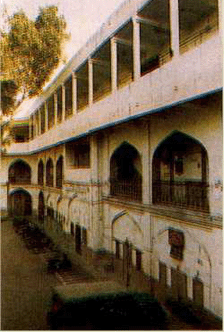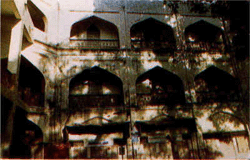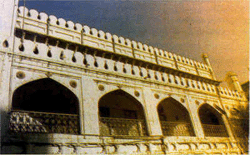Mughal Sarai
Introduction
 The Building which is used at present as an office complex by Surat Municipal Corporation (SMC) is one of the ancient monuments of Surat city and was built originally as a 'Sarai' or Musafarkhana (travellers' inn). It was built during the period of Mugal Emperor Shah Jahan in the year 1644 A.D. and was popularly known as 'Mugal Sarai'. During 18th century the same building was used as jail. Since 1867 the building was occupied by the present corporation.
The Building which is used at present as an office complex by Surat Municipal Corporation (SMC) is one of the ancient monuments of Surat city and was built originally as a 'Sarai' or Musafarkhana (travellers' inn). It was built during the period of Mugal Emperor Shah Jahan in the year 1644 A.D. and was popularly known as 'Mugal Sarai'. During 18th century the same building was used as jail. Since 1867 the building was occupied by the present corporation.
This building with its considerable architectural qualities as disposed by the skilful composition of its various parts combined with harmonious combination of arches, cornices, decorated parapets, sculptured patterns on the exterior facade etc. each being disposed in an artistic and effective manner upon a sound foundation with coherent strength is still intact and is in a very good state of preservation.
However, some changes are made lately in the original building but due care is taken so as not to harm the overall harmony of the structure. The central courtyard which at present is used for parking vehicles of the employees of the corporation still have huge trees in it hosting a wide variety of birds, giving it still the same touch of nature which it would have once enjoyed.
History
The Building which is used at present as an office complex by Surat Municipal Corporation (SMC) is one of the ancient monuments of Surat city and was built originally as a 'Sarai' or Musafarkhana (travelers' inn). It was built during the period of Mugal Emperor Shah Jahan in the year 1644 A.D. and was popularly known as 'Mugal Sarai'.
The detail description about the sarai was inscribed on two marble stones each 3.65 m long which were being placed at its entrance gateway itself till middle of the 19th century. But later on they were negligently dumped in one of the rooms of this sarai and were left unattended for quite long time. Thanks to the efforts of Mr. A.D. Banerjee; an officer of Archaeological Survey of India, that these inscriptions were transferred to the Prince of Wales Museum of Bombay in 1929 and history of Mugal Sarai could thus be preserved there.
The description was inscribed in the Arabian script by Mohammed Amin of Mashahad, the translation of which was published in 1925-26. According to these inscriptions it was stated that though this building was built as sarai during the rule of Emperor Shahjahan in the name of Almighty Allah it was in fact believed to be a heaven during those days. In the last line of the script the year of construction of the sarai was also mentioned.
The instructions regarding the usage of this sarai were inscribed in small sized letters in the margin space of the article. It was mentioned that no rent shall be levied from persons like learned scholars, and pilgrims going to Macca and Madina and any other sacred or religious individuals intending to halt in the sarai, and the allotment of rooms to the soldiers in this sarai shall be strictly prohibited.
It was also instructed that the income from rent charged to the travellers other than those specified above shall be used for maintenance and repair of the building; wages of watermen and sweepers; purchasing fodders for animals, and rest of the income should be donated to the pilgrims going to Macca-Madina.
This sarai was built by Eshak Beg Yazdi who was initially a chief guard for the family of Begum Mumtaz Mahal and was later on appointed as a leader of the fleet of about 1000 horse-riders. He was honoured as Hakikat-Khan in 1673 and was since then popularly known by that name only.
The Emperor Shah Jahan used to give the entire revenue earned from the Surat port to his daughter Jahan Ara in order to meet her daily expenses. The management of this income was being done by Hakikat Khan who also became the chief officer of the Surat city from 1640 and during that tenure itself he built this sarai (1644). It is said that he had built it on the basis of same planning principles as that for sarais of Esfahan.
During the period when this building was in the charge of Britishers it was utilised for storage of military weapons and also as a prison at later stage.
On 23rd April 1852 Collector Rozers incepted the Surat Municipality with its office in the building of Head Post Office, Nanpura.
Later on the Mugal Sarai was handed over by the government for using as a Municipal Office complex in the year 1864 at the instance of the then President of Surat Municipality Mr. T.C, Hope and it was then renovated at a substantial cost. The clock tower at its entrance was added after this only.
The offices of Surat Municipality were shifted to this monumental building in the year 1867. Since then it is used for the same purpose by SMC and the area in which this building is located is still known as 'Mugalisara'.
Feature
This imperial sarai bears a testimony of the richly decorated style and of a well constructed monument of Indo-lslamic architecture- a style of architecture which evolved due to spread of Islam in India. These qualities are visualised in the appearance of its exterior facade in the form of a series of arches and superb vaulting, utilized with impressiveness even in the interior of its halls. As seen in the above photograph the facade displays number of characteristic architectural features. Among the several skilful expedients is the disposition of the decorative parapet crowning the facade coupled with an ornamental finish to the small, dome shaped elements which surmount the principal angles of the building resembling the slender minarets.
Moreover, the shape of the arch at the entrance gateway is distinctive- instead of the angularity it assumes the contours of more suavity and grace. It is immediately followed by more decorative type of arch- a series of engrailed arches which was a predominant style during the period of Mugal, Shah Jahan in 17th century. A characteristic architectural element for most of the buildings of this era-the cornice which was considered remarkable for its size as well as for the closely ranked decorated brackets for its support is displayed in this building too.
The sculptured patterns which embellish these elements are so individual in character, that they constitute a definite school of plastic art. This ornamentation includes the motifs of an unusual kind, the prominent among which is the pattern in the arch spandrills, consisting of a voluted bracket holding a medallion, and the foliated finial above the arch, all singularly graceful. In addition to this, certain attractive patterns like that of some flowers, running borders and interlaced symbols moulded in stucco are also incorporated all along the facade.
 The courtyard with a fountain in its centre is contained all around by three rows of arcades - provided one above the other; the one at the ground floor level being merely for ornamentation to the walling, but both the upper level rows disclose the arched corridors running the whole length of the sides. The surface of the inside walls enclosing this courtyard though left without any decorative treatment are so disposed as to comprise a correct element in the composition and produce a total effect well-balanced and satisfying to the eye. This is evident from the arches on the wall surface sunk in the face with - elegant and suitable shape, all of them being paneled out so as to follow the dimensions of doorways as well as those of windows and ventilators. This feature is displayed in the above photograph.
The courtyard with a fountain in its centre is contained all around by three rows of arcades - provided one above the other; the one at the ground floor level being merely for ornamentation to the walling, but both the upper level rows disclose the arched corridors running the whole length of the sides. The surface of the inside walls enclosing this courtyard though left without any decorative treatment are so disposed as to comprise a correct element in the composition and produce a total effect well-balanced and satisfying to the eye. This is evident from the arches on the wall surface sunk in the face with - elegant and suitable shape, all of them being paneled out so as to follow the dimensions of doorways as well as those of windows and ventilators. This feature is displayed in the above photograph.
This style is ensured even at the corners which are designed in such a fashion as to reveal the consistency and total harmony with the remainder of the conception. The quality of the construction materials and methodologies can be judged from the present state of this building which is still intact.


